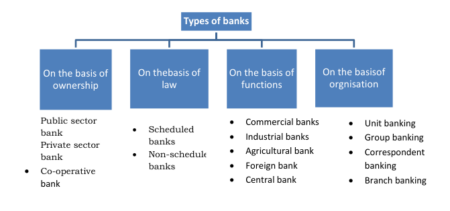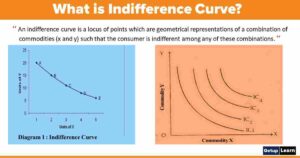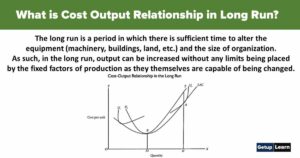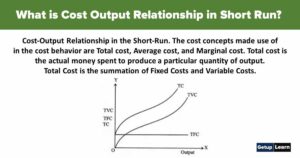Table of Contents
- 1 What is Demand?
- 2 Definition of Demand
- 3 Importance of Demand
- 4 Types of Demand
-
5 Factors of Demand
- 5.1 Price of Commodity (Px )
- 5.2 Availability of Substitutes and Compliments and Their Prices (Pr )
- 5.3 Income Level (y)
- 5.4 Number of Consumers (N)
- 5.5 Distribution of Wealth (D)
- 5.6 Consumers, Tastes, Preferences and Fashion (TPF)
- 5.7 Possibilities of Price Changes in Near Future (Pf)
- 5.8 Climate and Seasons (C)
- 5.9 Business Conditions (B)
- 5.10 Advertisement and Sales Promotion (Ad)
- 5.11 Availability of Consumer Credit (CC)
- 5.12 Government Control (GC)
- 5.13 Improvement in Quality (I)
- 5.14 Changes in Money Supply (M)
- 5.15 Changes in Population (CP)
- 6 Demand Schedule
- 7 Law of Demand
- 8 FAQ Related to Demand
What is Demand?
Demand is common parlance means the desire for an object. But in economics demand is something more than this. In economics “Demand” means the quantity of goods and services which a person can purchase with a requisite amount of money.
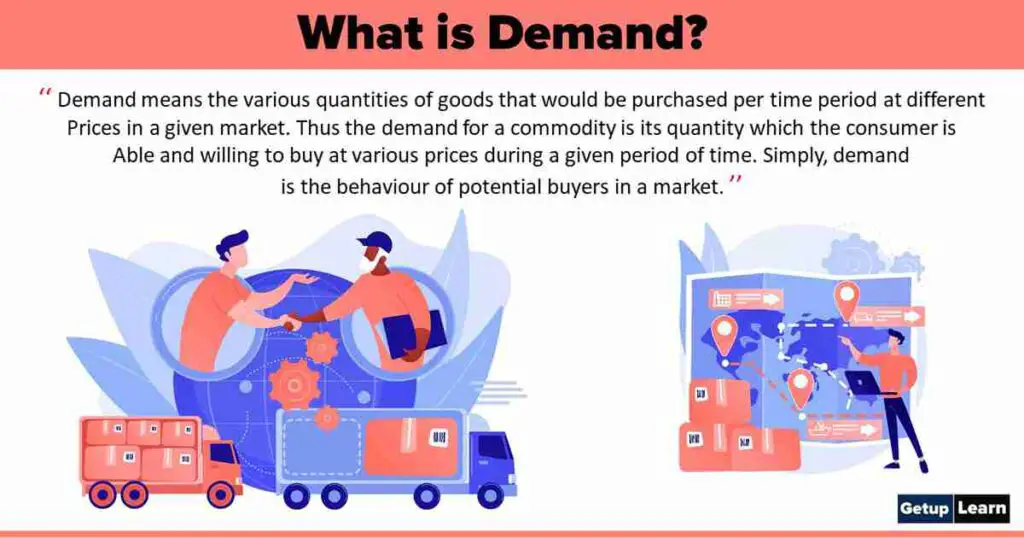
Table of Contents
The concept ‘demand’ refers to the quantity of a good or service that consumers are willing and able to purchase at various prices during a period of time. In economics, demand is something more than desire to purchase. For instance, a beggar may desire food, but due to lack of means to purchase it, his demand is not effective. Thus effective demand for a thing depends on:
- Desire
- Means to purchase
- On willingness to use those means for that purchase. Unless demand is backed by purchasing power or ability to pay, it does not constitute demand.
Definition of Demand
These are some definitions of demand given by economists:
[su_quote cite=”Prof. Hidbon”]Demand means the various quantities of goods that would be purchased per time period at different prices in a given market. Thus the demand for a commodity is its quantity which the consumer is able and willing to buy at various prices during a given period of time. Simply, demand is the behaviour of potential buyers in a market.[/su_quote]
[su_quote cite=”Benham”]The demand for anything, at a given price, is the amount of it, which will be bought per unit of time at that price.[/su_quote]
[su_quote cite=”Stonier and Hague”]Demand in economics means demand backed up by enough money to pay for the goods demanded”. In other words, demand means the desire backed by the willingness to buy a commodity and purchasing power to pay. Hence desire alone is not enough. There must have necessary purchasing power, ie, .cash to purchase it.[/su_quote]
For example, everyone desires to possess a Benz car but only a few have the ability to buy it. So everybody cannot be said to have a demand for the car. Thus the demand has three essentials-Desire, Purchasing power and Willingness to purchase.
Importance of Demand
Demand is considered the basis of the entire process of economic development, hence demand plays an important role in the economic, social and political fields. The importance of demand may be studied under the following heads:
- Importance in Consumption
- Advantageous to Producers
- Importance in Exchange
- Importance in Distribution
- Importance in Public Finance
- Importance of Law of Demand and Elasticity of Demand
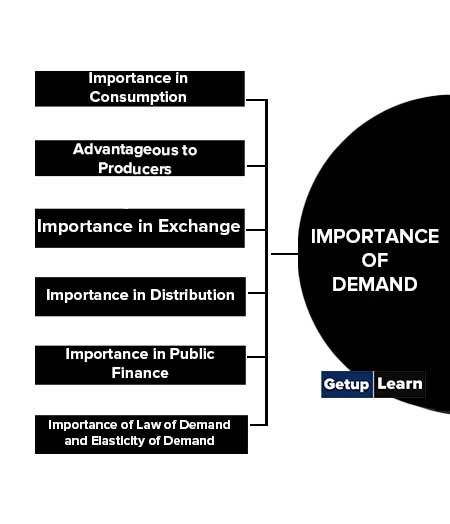
Importance in Consumption
Demand implies the schedule of quantities to be purchased over a specific period of time at various prices. A consumer determines the number of various commodities consumed on the basis of his demand.
Advantageous to Producers
Producers maximize the profit by determining the nature, variety, quantity and cost of production on the basis of demand for various commodities and by controlling the supply at the appropriate time. A monopolist also keeps in mind the nature of demand while maximization of his profit.
Importance in Exchange
Quantity demanded is the purchase of a commodity in a certain quantity at a certain price, therefore it is exchanged. This means that the production, purchase and sale of a particular commodity of a particular quality and quantity take place in demand and it is the process of exchange.
The means of exchange viz. money, banking, insurance, transportation, communication etc. are also affected by demand. Continuous growth in demand proves helpful in the progress of exchange as well as the economic development of the country. The basis for the determination of market price, normal price, long-term price, monopolistic price or price discrimination is demand.
Importance in Distribution
Aggregate social production is determined on the basis of social demand. Production scale is increased with an increase in demand. Resources from various sources are procured to fulfil this increased demand. The share in the national product of a factor of production depends upon its demand.
The interest rates remain high in a capitalistic economic system due to the high demand for capital in the production process and on the other hand in a labour-intensive economic system, it is quite natural that wage rates of labour are high due to the high demand for labour.
Importance in Public Finance
Maximization of social welfare is the prime objective of the process of public finance. Sources of public revenue (inflows) and items of public expenditure (outflows) are determined to achieve this objective. The government collects revenue through direct and indirect taxes. The effect of tax on demand is kept in mind while levying taxes.
Income tax is not levied on the general public because higher rates of direct taxes tend to reduce the income and the demand for commodities in society. Similarly, indirect taxes like excise duty, sales tax, octroi, import-export duty etc. are determined by keeping in view their impact on the overall demand.
Items of public expenditure are also determined on the basis of demand. The poor class of the society does not have the potential to spend much on social services e.g. education, health, transportation, medical services, library etc. Hence to increase the demand for those services a substantial part of public expenditure on those heads is advised for increasing social welfare.
Importance of Law of Demand and Elasticity of Demand
Importance of the law of demand and elasticity of demand: The Law of Demand and Elasticity of demand are the most important concepts in economics.
Importance in Religion, Culture and Politics:- Demand for various commodities in society at various points of time is also very important from the religious, cultural and political points of view. Efforts are made to fulfil the demand for various commodities which arises at the time of various social or religious festivals.
Political activities such as the election of government create the demand for banners, posters, etc. which provide employment to a large section of society. Even destructive commodities such as fighting equipment and weapons are required to be produced to fulfil their demand at wartime.
Types of Demand
These are types of demand explained briefly below:
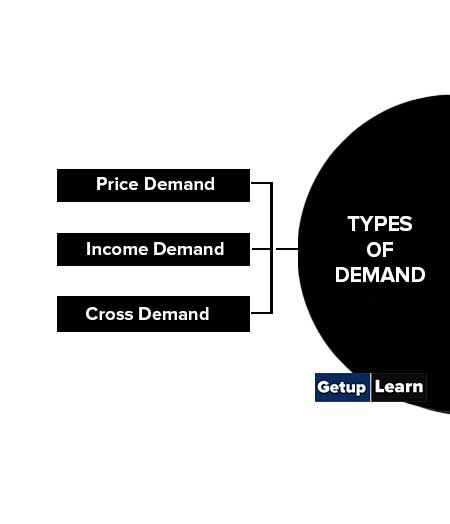
Price Demand
Price demand implies the different quantities of the commodity demanded by the consumers at various prices for a particular period of time. In the study of price demand it is assumed that other things remain unchanged i.e. the income, habits, tastes, fashion, etc., do not change. In fact, what we have studied in the earlier pages is related to price demand only. Price demand is shown in the diagram.

In the above figure, DD1 is the demand curve of the commodity X which shows the inverse relationship between price and quantity demanded of the commodity.
Income Demand
It shows the relation between the quantity demanded of a commodity and the income of the consumer. Income demand implies the quantity of a commodity purchased by the consumer at various levels of income, other things remaining the same. Another thing remaining same implies that the price of the commodity taste, fashion, etc. do not change.
Cross Demand
The study of demand of a commodity X with changes in the price of related commodity Y (Assuming other things remain the same) is known as cross demand. Related goods are of two types—substitutes and complementary goods.
Factors of Demand
Demand for a commodity depends upon many factors like the price of the commodity itself, the price of its substitutes or complements, the income of the purchaser, and the nature of the commodity.
Factors affecting demand for durable consumer goods e.g. cars, washing machines, refrigerators, etc. are different from those affecting non-durable consumer products like foodstuff, soap, etc. Generally, demand is affected by the following factors:
- Price of the commodity (Px )
- Availability of Substitutes and Compliments and Their Prices (Pr )
- Income Level (y)
- Number of Consumers (N)
- Distribution of Wealth (D)
- Consumers, Tastes, Preferences and Fashion (TPF)
- Possibilities of Price Changes in Near Future (Pf)
- Climate and Seasons (C)
- Business Conditions (B)
- Advertisement and Sales Promotion (Ad)
- Availability of Consumer Credit (CC)
- Government Control (GC)
- Improvement in Quality (I)
- Changes in Money Supply (M)
- Changes in Population (CP)

Price of Commodity (Px )
The demand of a commodity depends on the price of the commodity. When price increases, demand will decrease and when price decreases, demand will increase. It means there is an inverse relationship between price and demanded quantity.
Availability of Substitutes and Compliments and Their Prices (Pr )
When the substitutes for a commodity are available demand is less. Similarly, demand rises with rising in the prices of substitutes and it falls with a fall in prices. For example, when tea and coffee both are available demand for tea is less. If the price of coffee falls demand for tea also falls and it rises with the increase in the price of coffee.
Demand rises with the availability of complementary goods and falls with rising in price. For example, the demand for cars increases if petrol price falls and the demand for cars falls with rising in the price of petrol.
Income Level (y)
Demand for a commodity depends upon the income of the consumer. Demand for normal goods rises if the income of consumers rises, but the demand for inferior or Giffen goods decreases because the consumer starts purchasing superior commodities in place of inferior goods. If the income of the consumer decreases demand for normal goods falls but the demand for inferior goods rises.
Number of Consumers (N)
The most important factor affecting demand is the number of consumers in the market. If the number of consumers is large demand is more and if the number of consumers is small demand for the commodity will be less.
Distribution of Wealth (D)
Luxurious goods are demanded more by rich people but a vast majority of people demand necessities of life only. When the government tries to reduce inequalities in the distribution of income in the society then the demand for luxurious goods declines and the demand for essentials and comforts rises.
Consumers, Tastes, Preferences and Fashion (TPF)
Demand for a commodity is affected by the consumer’s taste, preference and fashion. Demand for goods suitable to consumer’s tastes, preferences and fashion is more and will rise constantly. Similarly, the demand for goods disliked by the consumers will be less.
Possibilities of Price Changes in Near Future (Pf)
Possibilities of price changes in the near future for a commodity also affect its demand. If the possibility is that the prices will rise in near future the demand will rise and if the possibility is that the prices will fall in the near future the demand for the commodity will fall.
Climate and Seasons (C)
Different commodities are demanded in different seasons, for example, demand for electric fans, ice, cold drinks etc. rises in summer, whereas their demand is very low in winter. Similarly woollen clothes, tea etc. are demanded more in winter than in summer season.
Business Conditions (B)
The Demand for many commodities rises in the boom and demand for most of the commodities decreased in the depression. Consumers purchase more even at rising prices to save them off at higher prices in boom periods whereas they purchase less expecting a further fall in price in depression.
Advertisement and Sales Promotion (Ad)
Consumers are tempted to purchase the commodity when the usefulness of the commodities is communicated to them through effective advertisements. Therefore effective advertisements and sales promotion are useful for increasing the demand.
Availability of Consumer Credit (CC)
Demand for consumer goods rises with an increase in consumer credit facilities and demand for goods decreases with a fall in consumer credit.
Government Control (GC)
Demand decreases if the government imposes restrictions on the use of the commodity and it rises with the release of restrictions.
Improvement in Quality (I)
Either producer improves the quality of goods their demand increases and the demand falls if the quality of goods deteriorates.
Changes in Money Supply (M)
Demand rises if the money supply in the country increases and if the money supply decreases demand falls.
Changes in Population (CP)
Demand for every commodity will rise if the population in the country is rising continuously. But the demand varies with variations in age groups in the country where the population is stable.
Demand Schedule
Tabulation of the quantities of a commodity demanded at a particular point of time at various prices is known as a demand schedule.
[su_quote cite=”Benham”]A full account of the demand, or perhaps we can say, the state of demand for any goods in a given market at a given time should state what the volume (weekly) of sales would be at each of a series of prices. Such an account, taking the form of a tabular statement, is known as a demand schedule.[/su_quote]
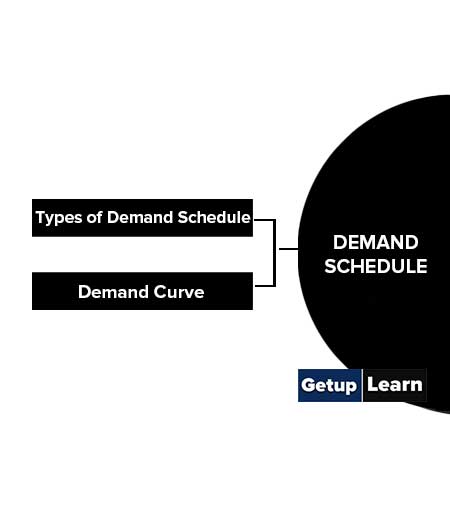
Types of Demand Schedule
A demand schedule establishes a working relationship between price and quantity demanded. Types of demand schedule are of two kinds:
Individual Demand Schedule
This demanding schedule indicates the quantities of a particular commodity demanded by an individual at a given time at each of a series of prices. But this does not mean that the prices given in the table are actually prevalent and the commodities are purchased in the given quantities at the given prices.
This table is formulated on the basis of past experience of a particular individual. But in reality, the present demand schedule of an individual may vary from that of his past demand schedule due to changes in his income, tastes, fashion etc.
The individual demand schedule of a person ‘A’ may be explained with the help of the following table:
Individual Demand Schedule
| P rice Per Kg. (Rs.) | Quantity Demanded Per Week (Kgs.) |
| 2.50 | 5 |
| 2.00 | 7 |
| 1.50 | 10 |
| 1.00 | 15 |
Market Demand Schedule
The market demand schedule is nothing but the total of the individual demand schedules of a commodity in the market. Market demand schedule may be explained with the help of an example:
Let us suppose that there are three buyers, viz. A, B, C are in the market for oranges.

In table first column shows the prices of oranges Rs. per dozen together with the last column showing the total of all the three consumers from the market demand schedule. The market demand of oranges at a price of Rs. 10 per dozen is 15 dozen.
Demand Curve
A demand curve is a diagrammatic representation of the demand schedule. A demand curve for a commodity shows the relationship between quantity demanded and price. A demand curve like the demand schedule is also of two types- (i) Individual demand curve, and (ii) Market demand curve.
The demand curve is derived from the demand schedule shown in the table given in the diagram.
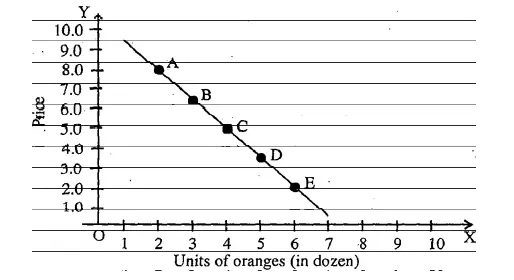
In the above diagram, the line joining the points A, B, C, D & E is the demand curve. A, B, C, D & E are different demand points that show various combinations of prices and quantities and indicate that the quantity demanded commodity increases with a fall in its price.
Law of Demand
The law of demand establishes a relationship between the quantity demanded and the price of a commodity. According to this law other things remain the same, the quantity demanded of a commodity increases with a fall in its price and the quantity demanded decreases with a rise in its price.
- Definition of Law of Demand
- Assumptions of the Law of Demand
- Characteristics of Law of Demand
- Reasons of Application of Law of Demand
- Exceptions of Law of Demand
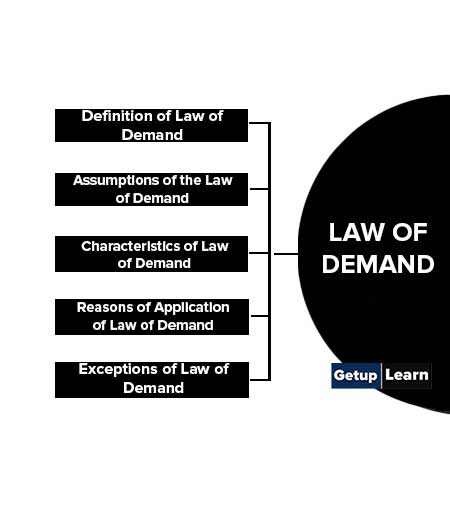
Definition of Law of Demand
These are definitions of law of demand by economists:
[su_quote cite=”Marshall”]The amount demanded increases with a fall in price and diminishes with a rise in price.” In this way, the law of demand shows an inverse relationship between the quantity demanded and the price of the commodity[/su_quote]
[su_quote cite=”Prof. Samuelson”]If a greater quantity of goods is put on the market, then other things being equal it can be sold only at a lower price.[/su_quote]
[su_quote cite=”St. Thomas”]At any given time the demand for a commodity or service at the prevailing price is greater than it would be at a higher price and less than it would be at a lower price.[/su_quote]
Assumptions of the Law of Demand
The law of demand will hold good only if ‘ceteris paribus’ (other things remaining the same) conditions are applied. ‘Other things remaining the same is called the assumptions of the law of demand. The following are the important assumptions of the law of demand:
- Psychological factors like habit, tastes and preferences of the consumers must remain unchanged.
- Consumer’s money income must be constant.
- The particular commodity in consideration must not be prestigious goods to the consumer.
- There must not be any substitutes for the commodity.
- Prices of other goods remain the same.
- Expectations about future price changes should not be there.
- Quality of the commodity must remain the same.
Diagram shows the demand curve based on the above-mentioned assumptions:
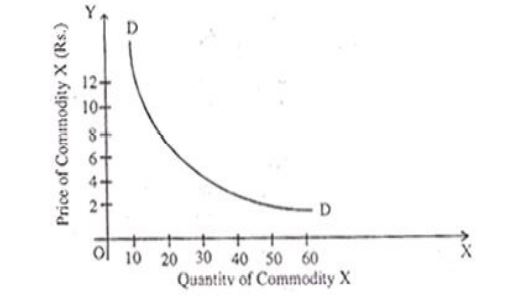
In the above diagram, the demand curve DD is sloping downward from left to right which shows that the quantity demanded increases with a fall in price and the quantity demanded diminishes with a rise in price.
Characteristics of Law of Demand
The following are the main characteristics of the law of demand:
- Inverse Relationship
- Price Independent and Demand Dependent Variable
- Other Things Being Equal
- Qualitative Statement
- It is Concerned With Certain Period of Time
Reasons of Application of Law of Demand
The law of demand applies on account of a number of factors that have been described here. These factors are also responsible for the demand curve sloping downward from left to right.
- Income Effect
- Substitution Effect
- Law of Diminishing Marginal Utility
- Changes in the Number of Buyers
- New Uses
Exceptions of Law of Demand
The Law of Demand is applicable if the assumptions underlying the law of demand hold good. But there are a few exceptions to the law of demand. Exceptions to the law of demand implies a situation when the quantity demanded increases with a rise in price or the quantity remains either the same or decreases with a fall in price.
In these exceptional cases, the demand curve is positively sloped, rising upward from left to right. The positively sloped demand curve is shown in the diagram:
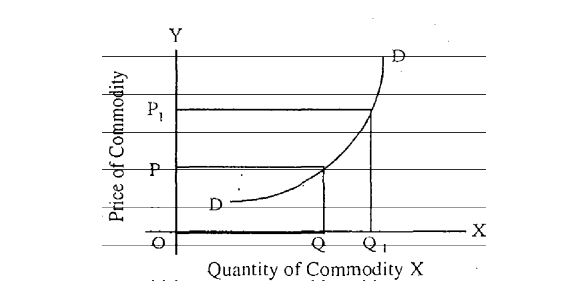
The following are the exceptions to the law of demand:
- The Giffen Goods
- Prestigious Goods or Goods of Snob Value or Articles of Distinction
- Highly Priced commodity (Ignorance and illusion on the part of the buyer)
- Speculation
- Necessaries of Life
- War or Emergency
- Specific Brand or Trade Mark Commodity
- Small Expenditure
What is the meaning of demand?
The demand for anything at a given price is the amount of it which will be bought per unit of time at that price.
What is the demand schedule and example?
Tabulation of the quantities of a commodity demanded at a particular point of time at various prices is known as a demanding schedule.
How do you explain the demand curve?
It is a diagrammatic representation of the demand schedule. It shows the relationship between quantity demanded and price.
What is meant by elasticity of demand?
The elasticity of demand is a responsive change in demanded quantity in response to the change in price.

